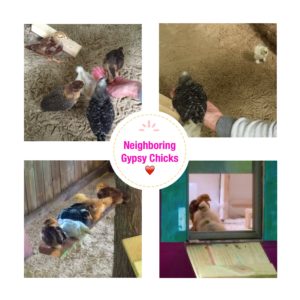Today I got some great ideas from my creative neighbors who have introduced hens into their backyard garden, including an artsy eclectic gypsy wagon coop!
Let’s see how the first few weeks of Kim and Tom’s urban adventure has gone.
“We made a lot of progress on our Coop and attached Chicken Run – to the point of being able to move the 2 week old chicks into the Coop. My intent was to habituate the chicks to the inside of the Coop so that they will know that the Coop is their house, someplace that provides safety, food and water. After 4 days inside, we opened the sliding door to allow access to their 400 sq. ft. run. At this point, the baby chickens truly became Chicken. It took a lot of coaxing to get the first chick to even consider leaving its sanctuary, after several false starts, she finally came down the ramp. 3 more followed, the rest, now realizing their flock mates were no longer inside with them started making a racket, chirping louder than we have ever heard. I then needed to go around the coop and gently persuade then from inside to go out and join the rest. Once outside, a whole new world was opened up to them. They ventured 20% into the space for about an hour when one of them decided enough was enough and back inside. The next day, the process went a bit easier and once outside; they covered more ground before going back inside. By day 3, by the time they were all inside, their little chicken feet marks covered the whole area. They are now comfortable enough that they will spend much of the day in the run and when dusk starts, they all start back up the ramp to spend the night in the coop.
So here is more of our process in the beginning………..
Once we picked the breeds of chicks we wanted, it then became a jigsaw puzzle dealing with the spreadsheet on the Hatcheries web site to find availability of all 6 during the same hatch. Hatcheries can time when an egg will hatch via temperature and air pressure. Monday is a popular hatch day as it works best for shipping.
We wanted them to all be the same age growing up to help prevent too many pecking order issues that can occur when you introduce a new chicken to the flock.
The breeds we picked…..
Barred Plymouth Rock – Barred Plymouth Rocks or “Barred Rocks,” as they’re called, are one of the most popular dual-purpose chickens on small farms today. They’re very friendly, great layers of large brown eggs and able to withstand cold weather quite nicely.
Orpington – Orpingtons are big, friendly dual-purpose birds originally developed in the UK. For many small farms and homesteaders, Orpingtons are the only way to go! They’re cold-hardy due to their fluffy plumage. Plus, they’re gentle and friendly on top of being good layers. The Buff Orpington is the most popular of all varieties of Orpington–a pretty, bright, pale “buffed” copper color that is striking as eye candy on a green lawn. They also come in Lavender and Blue.
Easter Egger – They are friendly and great layers of large eggs. While they chiefly lay blue or green eggs, they may (rarely) lay any egg color, including tinted, white, brown or even pinkish eggs. Their smaller body size makes them good in the heat. “Easter Eggers” are hybrids that carry the blue-egg gene and well as the “sweetness” gene
Rhode Island Red – Rhode Island Reds are held in such high esteem that they’re the official Rhode Island state bird. They were once hugely popular in America and today they’re making a comeback due to small flock owners (like us!). They lay exceptionally well; it’s not uncommon to have 300 eggs per year. They’re extremely cold hardy and hardy in general.
Welsummer – Welsummers are friendly, intelligent and easily handled birds that love to free range and forage for food but can also be kept in runs quite happily. The Welsummer is named after the village of Welsum, Holland, and was first imported into this country in 1928. Hens lay large, medium to deep brown eggs that are often speckled, making them very lovely, indeed! The Welsummer is an upright, active bird with a broad back, full breast and large full tail. When many people picture the stereotypical rooster, a Welsummer is what they have in mind–this was the same rooster featured on the corn flake boxes. The coloring on the eggs is so thick that if you catch it while the egg is still wet, you can wipe off some of the brown with a clean cloth! Keep in mind that, as with all dark egg layers, the eggs will vary in color, growing lighter as the hens get into the full swing of laying, and darkening again after a break in laying (like a molt).
White Silkie – This will be the smallest of the breeds we picked. Of all the ornamental chicken breeds, the Silkie Bantam is the most popular and most loved. Can’t you tell why? They’re the lap dog of the chicken world, complete with hair-like plumage and an incredibly sweet temperament. Silkies were originally bred in China, where they are still kept today. They have black skin and bones and 5 toes instead of the normal 4. According to a recent poll we conducted, Silkies are a favorite choice as a pet for children! When stacked up against super popular breeds like Orpingtons, Cochins, Brahmas and Easter Eggers, they were a top choice.
Thanks to www.MyPetChickens.com for the descriptions.


